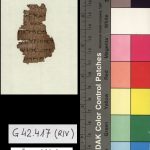| Artefact ID | 1462 |
| TM ID | TM 66065 |
| Findspot (DEChriM ID) | - () | Class | Textual |
| Material | Papyrus |
| Writing medium | Codex |
| Text content | Literary |
| Language | Greek |
| Description | Gregory-Aland 𝔓116, P116, P.Vindob. G 42417: Fragment of Hebrews 2,9–11; 3,3–6 |
| Selection criteria | Literary genre (Biblical), Nomina sacra |
| Date from | 300 |
| Date to | 350 |
| Dating criteria | Palaeography; the ed.pr. points out that characteristics of the script indicate an early dating, but dates it to the 6th/7th c. due to specific letters (i.a. ε, μ). Jaroš dates it to the 2nd/3rd c. due to its use of ιην rather than ιν for Ἰησοῦν, and lack of abbreviation for υἱός. This is criticized in Förster 2002 and discussed in Blumell 2009. Most recently, Orsini/Clarysse 2012 have proposed dating the fragment to the first half of the 4th c. |
| Absolute/relative date | Relative date |
| Archaeological context | Unknown provenance. |
| Accession number | Vienna, Nationalbibliothek G 42417 |


 Json data
Json data





